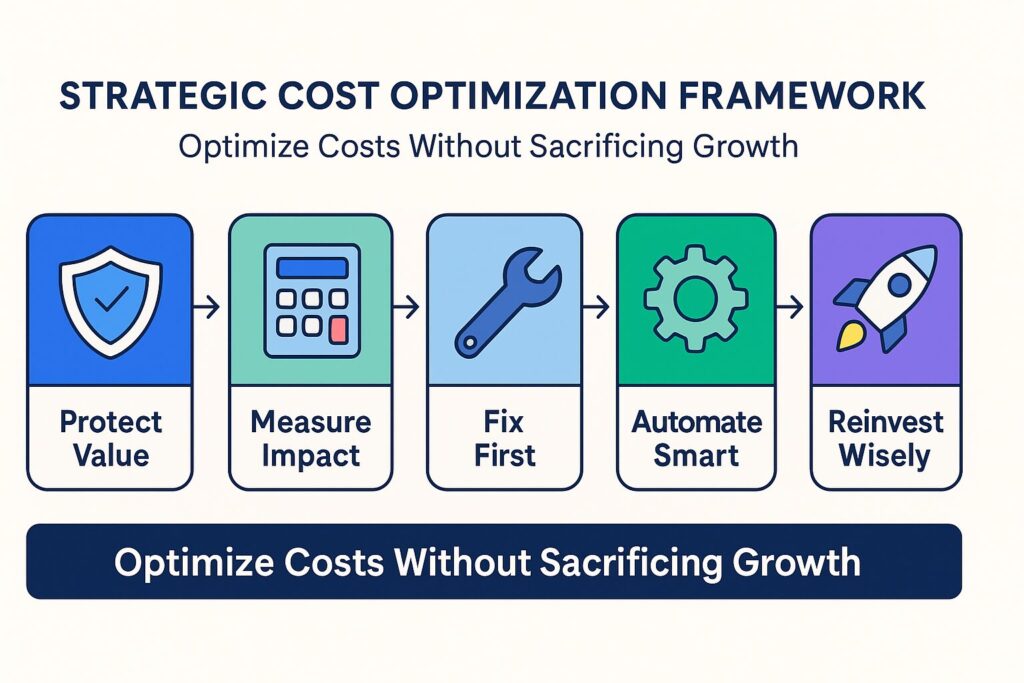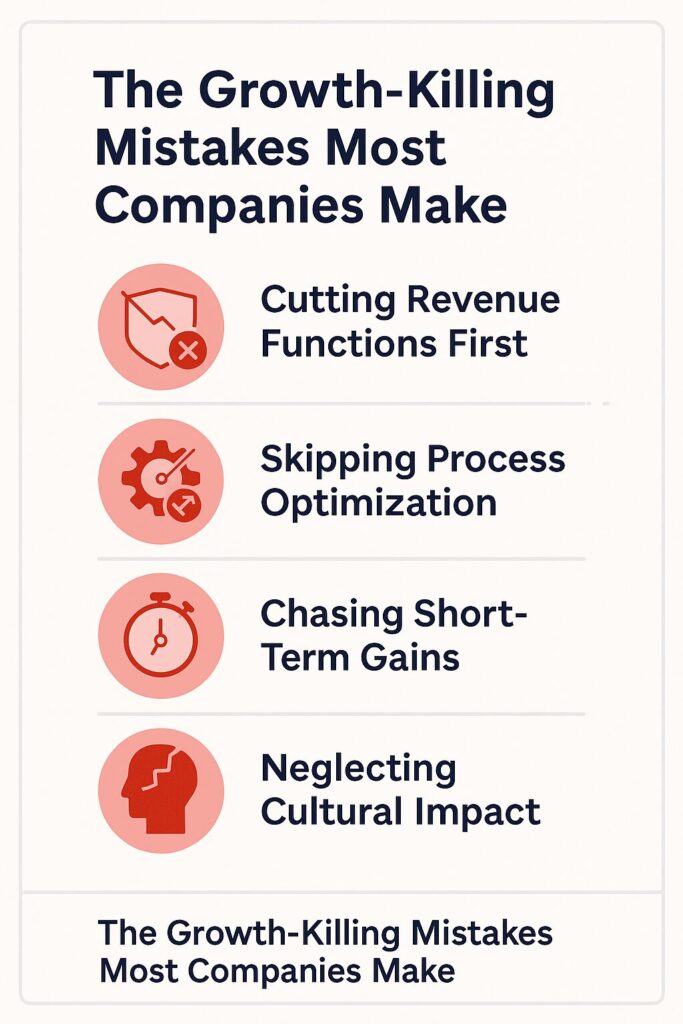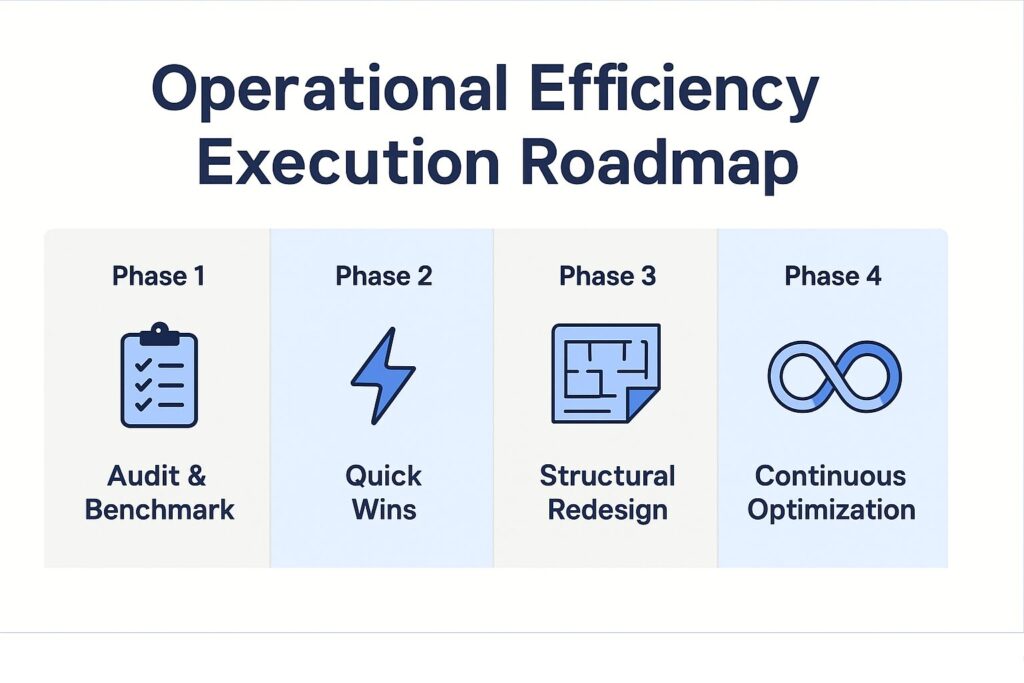Here’s the thing about cost-cutting: most companies do it the wrong way.
They see red ink on the P&L, panic, and start making aggressive budget cuts. Marketing budgets get slashed. Teams get downsized. Strategic initiatives get shelved. And, sure, the numbers look better for a quarter or two, until revenue starts to tank and they realize they’ve eliminated the activities that were driving growth.
I’ve watched this movie play out more times than I care to count. McKinsey research indicates that 70% of cost reduction programs fail to meet their targets, and an even higher percentage fail to sustain operational performance while reducing costs.
However, here’s what the best operators know:
“Actual operational efficiency isn’t about spending less, but about creating more value with every dollar you spend.” – Peter Drucker
The operational efficiency playbook will show you how to optimize costs strategically, automate the right processes, and drive growth while eliminating inefficiencies. Because when you get efficiency right, cost savings become growth investments, paving the way for innovation and expansion.
The Real Definition of Operational Efficiency (Hint: It’s Not Just Cost-Cutting)
Let’s get something straight from the jump. Operational efficiency and cost-cutting are not synonyms, although most finance teams treat them as if they are. It’s time to take control and think strategically.
Cost-cutting is subtraction. You identify expenses and eliminate them. It’s reactive, often desperate, and usually myopic.
Operational efficiency is multiplication. You identify waste, eliminate it, and redirect those resources toward higher-value activities that compound your growth.
Think of your business like a high-performance engine. Cost-cutting removes parts to make it lighter. Operational efficiency tunes the engine so it runs smoother, faster, and uses fuel more effectively.
One SaaS industry case study from Thornton Advisory Solutions illustrates the difference. A growing SaaS company faced rising churn and inconsistent outreach, but instead of slashing headcount, they improved operational efficiency. They implemented a customer success platform, created a centralized dashboard for account visibility, and used predictive analytics to flag at-risk customers. Routine updates were automated, freeing CSMs to focus on high-value engagement. The results were precise: churn fell, NPS rose, and customer success shifted from reactive problem-solving to proactive value creation.
That’s the core difference between operational excellence and operational panic: one builds a stronger engine, the other pulls parts out until it stalls.
The Strategic Cost Optimization Framework: Your Operational Efficiency Playbook

Real operational efficiency follows a methodology, not a mood. Here’s the framework I’ve used to achieve sustainable cost optimization without growth sacrifice:
Step 1: Protect Value (Map Core vs. Non-Core Activities)
Before you cut anything, you need to understand what drives value in your business. I use a modified version of Michael Porter’s value chain analysis to categorize every activity into three buckets:
- Revenue-generating activities: Directly contribute to customer acquisition, retention, or expansion
- Revenue-enabling activities: Support revenue generation but don’t directly create it
- Overhead activities: Necessary for business operations, but don’t impact revenue
The rule is simple: Protect revenue-generating activities at all costs. Optimize revenue-enabling activities. Scrutinize overhead activities ruthlessly. For instance, a high-value activity in a software company could be the development of a new feature that directly contributes to customer acquisition. In contrast, a low-value activity could be a manual data entry process that supports revenue generation but doesn’t directly create it.
Step 2: Measure Impact (Calculate Activity ROI)
For every activity in your value chain, calculate a simple cost-to-value ratio. Calculate this ratio by dividing the cost of the activity by the value it generates. Revenue impact isn’t always a matter of dollars and cents. Sometimes value comes from risk mitigation, compliance, or strategic positioning. But you need a method to compare the relative value of different investments.
I use this formula: Activity Value Score = (Revenue Impact × Strategic Importance) ÷ Total Cost
Activities with high scores get more resources. Activities with low scores get optimized or eliminated.
Step 3: Fix First (Redesign Processes Before Reducing Resources)
Here’s where most companies typically go wrong: they cut resources before addressing broken processes. Organizations that make drastic cuts without addressing root causes rarely achieve sustainable improvements.
Apply lean methodology principles to eliminate waste first:
- Remove redundant approvals and handoffs
- Standardize repeatable workflows
- Eliminate non-value-added activities
- Reduce cycle times and wait states
Only after you’ve streamlined the process should you consider resource adjustments.
Step 4: Automate Smart (Focus on Non-Core Functions)
Operational efficiency gets exciting when you automate non-core functions. Once you’ve identified low-value, high-frequency activities, automate them aggressively. But be strategic about it.
Focus automation efforts on:
- Data entry and processing tasks
- Routine communications and follow-ups
- Report generation and distribution
- Basic customer service inquiries
- Invoice processing and basic accounting functions
Automation or AI efforts should focus on freeing up human capacity for higher-value work that drives meaningful progress.
Step 5: Reinvest Wisely (Reallocate Savings into Growth Levers)
The step that separates operational leaders from operational bean-counters comes next. Reinvest every dollar you save through efficiency improvements into activities that compound growth:
- Product development and innovation
- Market expansion initiatives
- Customer acquisition and retention programs
- Team development and capability building
- Technology that scales your competitive advantage
The Growth-Killing Mistakes Most Companies Make

I’ve seen enough operational train wrecks to spot the patterns. Here are the efficiency mistakes that destroy more value than they create. These mistakes are detrimental to operational efficiency because they often lead to short-term gains at the expense of long-term growth. They neglect the cultural and talent impact of efficiency initiatives and skip process optimization, a crucial step in achieving sustainable efficiency.
1. Cutting Revenue-Generating Functions First
Sales and marketing budgets often appear to be easy targets because they’re large and variable. But cutting revenue generation to reduce costs is like unplugging your refrigerator to save on electricity. Technically, it works, but you’ll regret it quickly.
2. Skipping Process Optimization
Research consistently shows that improving processes before reducing headcount delivers stronger long-term results. For example, Motorola’s continuous improvement program led to a 25% increase in employee satisfaction by streamlining workflows and enhancing collaboration, demonstrating that operational gains can be achieved by improving the way work is done, rather than by reducing the workforce.
The same principle holds in SaaS. A case study from Thornton Advisory Solutions demonstrates how a growing software company reduced churn and improved NPS by investing in a customer success platform, centralizing account data, and automating routine tasks while retaining its entire team.
3. Chasing Short-Term Gains
Quarterly thinking kills operational excellence. Actual efficiency improvements take time to implement and even longer to show compound returns. Companies that pursue quick cost cuts often sacrifice their long-term competitive positioning for short-term margin improvement.
4. Neglecting Cultural and Talent Impact
Every efficiency initiative sends cultural signals about what you value. Cutting learning and development budgets signals that growth isn’t significant. Eliminating team events signals that culture doesn’t matter. The best operational leaders consider the second- and third-order effects of every decision.
Operational Efficiency Playbook: Best Practices for Scaling Operations
After implementing operational efficiency programs across industries, here are the practices that consistently deliver sustainable results:
Embed Continuous Improvement Culture
Make operational excellence everyone’s job, not just the operations team’s responsibility. The companies with the best efficiency track records have systematic improvement processes built into their DNA.
Implement regular “process retrospectives” where teams identify bottlenecks, waste, and improvement opportunities. Make it safe to suggest changes and quick to test new approaches.
Align Efficiency Projects with Strategic Objectives
Every operational efficiency initiative should align with a strategic business goal. Don’t optimize for optimization’s sake. Optimize to enable the business strategy you are trying to execute.
- If your strategy involves digital transformation, modernize legacy systems and integrate data flows across platforms.
- If your strategy is market expansion, optimize processes that support scaling to new markets.
- If your strategy focuses on product innovation, optimize R&D workflows and decision-making processes to drive efficiency.
- If your strategy is customer retention, streamline onboarding, support, and account management workflows.
- If your strategy is cost leadership, automate repetitive operational tasks and renegotiate supplier agreements.
- If your strategy is rapid scaling, strengthen hiring, training, and cross-team communication processes.
- If your strategy is premium positioning, refine quality control, service delivery, and brand consistency processes.
- If your strategy is mergers and acquisitions, align integration workflows and centralize shared services.
Integrate Real-Time Performance Tracking
You can’t manage what you don’t measure, and you can’t optimize what you measure infrequently. The best operational leaders use real-time dashboards that track both efficiency metrics and business outcomes.
Set up KPIs that track:
- Process cycle times
- Resource utilization rates
- Error rates and rework frequency
- Customer satisfaction scores
- Employee productivity metrics
Cross-Functional Ownership of Efficiency Targets
Operational efficiency isn’t just an operations problem. It’s a business problem that requires business-wide solutions. The most successful efficiency programs have executive sponsors from multiple functions working together.
Form cross-functional efficiency teams to make improvements practical, sustainable, and aligned with business needs. Include representatives from operations, finance, technology, and the business units you’re optimizing.
Tools and Systems That Enable Scalable Efficiency
The right tools can multiply your operational efficiency efforts. Here’s the technology stack I recommend for scaling efficient operations:
Operations Management Platforms:
- Airtable for flexible process management and workflow tracking
- Asana for project coordination and team alignment
- Smartsheet for complex process orchestration
- Monday.com for customizable project and operations workflows
- ClickUp for all-in-one task, document, and goal tracking
Process Mining and Optimization:
- Celonis for discovering process inefficiencies in complex workflows
- UiPath for robotic process automation and task optimization
- Process Street for documenting and running recurring workflows
- Signavio for business process modeling and optimization
- Kissflow for workflow automation and process tracking
Automation Layers:
- Zapier for simple integrations and workflow automation
- Microsoft Power Automate for enterprise-grade process automation
- n8n for custom automation workflows
- Make for a visual, advanced workflow automation
- Workato for large-scale enterprise automation
Knowledge Management:
- Notion for centralized documentation and SOP management
- Confluence for enterprise knowledge management
- Guru for context-aware knowledge delivery
- Slab for modern team knowledge sharing
- Tettra for internal team wikis and documentation
Building an integrated technology stack eliminates manual handoffs, reduces context switching, and provides visibility into process performance.
Building a Resilient Cost Structure for Long-Term Success
Actual operational efficiency extends beyond optimizing current operations and building cost structures that can adapt to changing market conditions without incurring significant costs.
Optimize Your Variable vs. Fixed Cost Ratio
Resilient businesses maintain cost structures that flex with revenue fluctuations. The goal isn’t to make everything variable. Determine which costs remain fixed and explain why.
Fixed costs should be investments in capabilities that create competitive advantages, such as core team members, essential technology infrastructure, and strategic assets.
Variable costs should be activities that scale directly with business volume, such as transaction processing, customer acquisition, and usage-based services.
Implement Scenario Planning for Market Shifts
Build operational flexibility into your cost structure by planning for multiple scenarios. What would happen to your operations if revenue dropped 20%? What if it grew 50%? What if your biggest customer left or your main competitor slashed prices?
For each scenario, identify which costs you could quickly adjust without damaging core capabilities. Rather than pessimistic planning, you’re building operational resilience.
Download MY FREE Operational Scenario Planning Notion Template
Master Vendor and Supplier Renegotiation
Most companies accept vendor pricing as fixed, but everything is negotiable if approached strategically. Create win-win scenarios that deliver value for both parties.
Strategies that work:
- Consolidate vendors to increase purchasing power
- Negotiate volume discounts based on growth projections
- Trade longer commitments for better rates
- Bundle services for package pricing
- Explore partnership arrangements that align incentives
Design Agile Workforce Structures
The future of operational efficiency lies in workforce agility, the ability to scale team capacity up and down based on business needs without losing core capabilities.
Workforce agility means strategically balancing full-time employees, contractors, freelancers, and service providers to create maximum flexibility while maintaining quality and cultural alignment.

Your Operational Efficiency Execution Roadmap
Implementation is everything. Here’s the proven 4-phase roadmap for rolling out operational efficiency improvements:
Phase 1: Audit and Benchmark (90 Days)
Goals: Establish baseline performance metrics and identify improvement opportunities
Key Activities:
- Complete value chain mapping for all significant business processes
- Calculate cost-to-value ratios for key activities
- Benchmark performance against industry standards
- Identify quick wins and strategic improvement opportunities
Success Metrics: Complete process inventory, baseline KPI dashboard, prioritized improvement pipeline
Phase 2: Quick Wins Implementation (3-6 Months)
Goals: Generate early momentum and fund larger improvements
Key Activities:
- Implement high-impact, low-effort process improvements
- Deploy automation for routine tasks
- Eliminate obvious waste and redundancies
- Establish measurement systems for tracking progress
Success Metrics: 15-20% improvement in target efficiency metrics, positive ROI from initial investments
Phase 3: Structural Redesign (6-12 Months)
Goals: Implement systematic process redesigns and technology improvements
Key Activities:
- Redesign core business processes using lean principles
- Deploy integrated automation platforms
- Restructure teams and roles for optimal efficiency
- Implement comprehensive performance management systems
Success Metrics: 30-40% improvement in operational efficiency, measurable impact on business outcomes
Phase 4: Continuous Optimization Cycle (Ongoing)
Goals: Embed operational excellence as a core organizational capability
Key Activities:
- Regular process retrospectives and improvement sessions
- Ongoing automation and optimization projects
- Advanced analytics and predictive optimization
- Cultural reinforcement of a continuous improvement mindset
Success Metrics: Sustained efficiency improvements, employee engagement in improvement activities, competitive advantage through operational excellence
The Bottom Line: Efficiency Is Leadership, Not Just Management
Leaders use efficiency to create options. Managers use efficiency to eliminate problems.
When you approach operational efficiency strategically, you don’t just reduce costs; you also enhance productivity. You create organizational leverage that compounds over time.
Companies that thrive in competitive markets have the most efficient resource allocation, the most streamlined value creation, and the fastest ability to adapt to changing conditions.
Your operational efficiency playbook builds the systematic capabilities that help you scale faster, compete more effectively, and create greater value for everyone involved.
Start improving your operations today. Download the Operational Scenario Planning Notion Template and begin the Audit & Benchmark stage of your efficiency playbook now.
The companies winning in today’s market don’t just cut costs; they strategically optimize resources to fuel sustainable growth.
Want to dive deeper into operational strategy? Connect with me on LinkedIn for more insights on building scalable and efficient operations that drive sustainable growth.
Related Articles
Weekly Review Ritual That Will Skyrocket Your Focus Fast
The Modern COO: From Operations to Strategic Growth Architect
Boost Startup Growth with a 3-Layer Ops System
Unlock Better Leadership: Use the Radical Candor Framework Today
Build a Team That Runs Without You – Remarkable Autonomy Now
About the Author
I write about:
- AI + MarTech Automation
- AI Strategy
- COO Ops & Systems
- Growth Strategy (B2B & B2C)
- Infographic
- Leadership & Team Building
- My Case Studies
- Personal Journey
- Revenue Operations (RevOps)
- Sales Strategy
- SEO & Digital Marketing
- Strategic Thinking
📩 Want 1:1 strategic support?
🔗 Connect with me on LinkedIn
📬 Read my playbooks on Substack

Leave a Reply